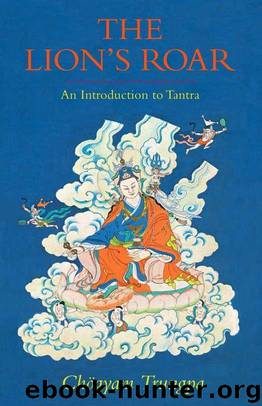The Lion's Roar: An Introduction to Tantra (Dharma Ocean Series) by Trungpa Chogyam

Author:Trungpa, Chogyam [Trungpa, Chogyam]
Language: eng
Format: azw3, epub
Publisher: Shambhala Publications
Published: 2010-09-28T03:00:00+00:00
FIVE
Overcoming Moralism
WE HAVE DISCUSSED the hinayana level represented by the shravakayana and the pratyekabuddhayana and the mahayana level, represented by the practice ideal of the bodhisattva. Last, we discussed the shunyata principle. At this point, instead of discussing the first tantric yana, the kriyayoga tantra, it might be helpful to give an introduction to tantra as a whole. We could get into the details of the six tantric yanas later on.
As has been indicated, the impermanence, suffering, and egolessness that we discover on the hinayana level play an extremely important part, a crucial part, in tantra as well. We cannot deny this. It is important to understand and acknowledge that we are not just transcending hinayana and latching on to the higher hopes of tantra. Likewise, we cannot ignore the bodhisattva’s path, involving the transplantation of bodhichitta into one’s mind and the practice of the six paramitas.1 Also the bodhisattva’s understanding of nonduality is quite important.
If seems that we do need these technical understandings in order to understand the buddhadharma. The idea of the buddhadharma is not particularly to make you into professors or scholars as such. Nevertheless, when we discuss big ideas, powerful ideas, those ideas have to have some specific elements to relate with. So tantra is desperately dependent on an understanding of the hinayana and mahayana, always. Some little technical knowledge of the hinayana principles concerning reality and the mahayana’s principles of morality is a basic necessity, absolutely important. If you don’t have any understanding of those, probably you will miss the whole point of vajrayana, or tantra.
People in the West usually think that tantra is concerned purely with pranayama, mudras, visualizations, and so on.2 They think that’s what tantra is all about, which is not quite true. There’s something more than that.
To begin with, tantra is based on the understanding of who is practicing tantra. Who are we? Who am I? If you asked a tantric practitioner, “Who are you?” he would automatically say, using the same logic developed on the hinayana level, “I am a collection of stuff that actually doesn’t exist, the five skandhas.” This is also the hinayana answer and the mahayana answer. And if you asked the tantric practitioner, “Why are you practicing this path?” he would automatically say, “Because I have surrendered myself, and my work is dedicated to the benefit of all sentient beings.” This is a pragmatic combination of both the hinayana (“I’ve surrendered”) and the mahayana (“I’ve decided to dedicate my life to the benefit of all sentient beings”).
The question might be asked? “What is the basic need to go beyond the hinayana and mahayana? Why don’t we stay on in the hinayana and perfect the hinayana? Or why don’t we stay on in the mahayana and perfect the mahayana? What’s the point of going beyond those into another area?” The mahayana practitioner would say, “The perfection of the hinayana is the mahayana; I can’t help it.” And the tantric practitioner would say, “The perfection of the mahayana is the vajrayana; I can’t help it.
Download
The Lion's Roar: An Introduction to Tantra (Dharma Ocean Series) by Trungpa Chogyam.epub
This site does not store any files on its server. We only index and link to content provided by other sites. Please contact the content providers to delete copyright contents if any and email us, we'll remove relevant links or contents immediately.
The Way of Zen by Alan W. Watts(6437)
Ego Is the Enemy by Ryan Holiday(5211)
The Art of Happiness by The Dalai Lama(3995)
The Book of Joy by Dalai Lama(3840)
Why Buddhism is True by Robert Wright(3362)
Spark Joy by Marie Kondo(3178)
Shift into Freedom by Loch Kelly(3088)
Happiness by Matthieu Ricard(2949)
A Monk's Guide to a Clean House and Mind by Shoukei Matsumoto(2836)
The Lost Art of Good Conversation by Sakyong Mipham(2475)
The Meaning of the Library by unknow(2459)
The Unfettered Mind: Writings from a Zen Master to a Master Swordsman by Takuan Soho(2196)
The Third Eye by T. Lobsang Rampa(2195)
Red Shambhala by Andrei Znamenski(2110)
Anthology by T J(2109)
The Diamond Cutter by Geshe Michael Roach(1982)
Thoughts Without A Thinker: Psychotherapy from a Buddhist Perspective by Epstein Mark(1930)
Twilight of Idols and Anti-Christ by Friedrich Nietzsche(1792)
Advice Not Given by Mark Epstein(1786)
